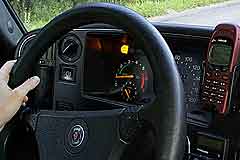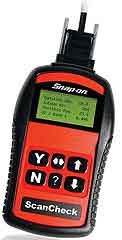You probably heard the urban legend about the motorist who put tape over a glowing LOW OIL light, then turned up the radio to drown out the knocking rod bearings. Those dials, warning lights and LED messages on your dash provide important information that can save you the cost of a big repair, if heeded promptly.

When you start your vehicle, all the warning lights should glow for a few seconds. Make sure they come on and if not, find out why and make necessary repairs. Otherwise, you won’t get a warning about a problem. If a light continues to glow for more than a minute or so, there is a problem that needs attention.
If while driving, a red light starts glowing, pull over, stop and turn off the engine immediately! Don’t try to restart the engine until the source of the problem is found and repaired. Indeed, if a light comes on for low oil pressure or overheating, it may be too late and permanent damage may already have occurred. A light for low battery voltage may be the result of an accessory belt failure that could lead to other problems, or a dead battery. A brake warning light is, of course, a safety issue.
Most vehicles now have a CHECK ENGINE light. When it comes on, it could mean a whole lot of things, and probably will take a technician to decipher why. However, there are a couple of instances that I experienced that were quite simple to correct. If the CHECK ENGINE comes on immediately after refueling, check to make sure the filler cap is tightly secured. Today, caps are closely monitored as part of the emission control system and a loose or missing cap will result in a warning. Also if you have disconnected the battery cables or had a completely dead battery, the light might glow while the computer is reprogrammed. Drive for a few miles and it should go out.
Oh yes, read your owner manual. It may provide clues, and solutions, for CHECK ENGINE situations.
If the CHECK ENGINE light comes on and there are other symptoms like hard starting, engine missing, strange odors, new sounds or poor performance, there is bigger problem that needs attention. Also you will not be able to pass a smog test with the CHECK ENGINE light glowing.

Since 1996, in some cases as early as 1994, all vehicles have been equipped OBD II (On-Board Diagnostic II) systems. Earlier ones used a less sophisticated OBD I system. OBD-II provides almost complete engine control and also monitors parts of the chassis, body and accessory devices, as well as the diagnostic control network of the vehicle. OBD-II provides a universal inspection and diagnosis method to be sure the vehicle is performing up to original equipment manufacturer (OEM) standards. If not, usually the CHECK ENGINE will come on.
The data provided by OBD-II system can often pinpoint the specific component that has malfunctioned, saving substantial time and cost compared to guess-and-replace repairs. You might consider purchasing a OBD II Scanner so you can read the trouble codes, just like the technician, when the CHECK ENGINE light comes on. They now cost under $200. You might not be able to fix the problem, but it would be nice if you could drive the vehicle without further problems, or have to call a tow truck. Bring the scanner with you when checking out a potential used car purchase. Also while you might not be able to make a repair diagnosis with the scanner, you will be able to relate the problem to a service writer or mechanic saving repair cost or even prevent getting taken.



